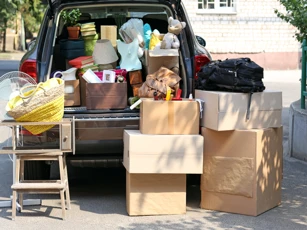 Written by: Danny Belton - Head of Lending
Written by: Danny Belton - Head of Lending
Planning to decorate before you move can help alleviate some of the stress and hassle associated with the house move itself, as you’ll already have a great idea of how you envision the space when unloading boxes and furniture.
Get measuring
It’s a good idea to request an additional viewing ahead of move-in day so you can measure for furniture and any potential renovations you may be thinking about. Alternatively, your estate agent will be able to supply detailed floor plans.
Whether you prefer a good old fashioned tape measure, or want to use mobile tools/apps, there are plenty of quick, inexpensive ways to get the dimensions you need. Remember to note down placement of windows, doors, and plug sockets. This will allow you to truly visualise how each room can be furnished, and ensures electronic items are appropriately placed.

Freshen up
A fresh coat of paint is a transformative, but relatively inexpensive, way to personalise your new space. It’s important to consider the functionality and available light of the space, as this will help inform which shades you pick. You may also want to consider opting for an accent wall in a bold colour, patterned wallpaper, or even panelling and wainscoting for a touch of elegance.
Given that you won’t yet be able to try paint samples on the walls, there are a number of paint apps available that can give you a general idea of how a shade can look in your space.
Let there be light
It’s worth noting where the natural light falls in each room, as this will help inform choices of paint colours and even where you position your furniture. From this, you’ll be able to determine whether curtains or blinds are more suitable for your space.
In terms of fixtures, think of the function of the room before deciding how to approach. Utilise overhead fixtures for general illumination, add task lighting like table lamps for specific areas, and consider accent lighting if you’re thinking of highlighting artwork or want to create a cosy atmosphere.

Storage solutions
Work smart by pre-planning storage solutions for each room. This could involve installing shelving, adding closet organisers, or using furniture with built-in storage. Don't underestimate the power of repurposing secondhand furniture either. For example, an old coffee table could be transformed into an ottoman, ladders into shelving, and drawers into planters. The possibilities are endless, and you’ll be doing your bit for the planet as well as saving some pennies.
New flooring
The foundation of any room is the floor, and your new home offers the perfect canvas to create a space that reflects your style. Depending on the existing flooring in your new home, you might explore refinishing hardwood floors, replacing worn carpets, or adding area rugs for pops of colour and to add character.
You’ll be able to gather quotations for new flooring based on your square footage measurements. Most flooring companies offer free in-home consultations, where they can measure your space and provide recommendations based on your budget and desired style.
The beauty of the ‘before’ and ‘after’
Last but not least, make sure to take photos of the empty space before you move in. This will be invaluable when it comes to planning furniture placement, creating mood boards, and visualising your decorating ideas. It also allows you to look back on your progress once you’ve finished decorating, so you can see just how far you’ve come!
While you’re thinking about how to decorate your new home, you should also consider how you’re going to protect it should the worst happen. A change in circumstances warrants a discussion and review of your current protection policies, so get in touch with our team of mortgage advisers today to ensure your property is fully covered against all of life’s twists and turns.
Important information
Your home may be repossessed if you do not keep up repayments on your mortgage.
There may be a fee for mortgage advice. The actual amount you pay will depend on your circumstances. The fee is up to 1% but a typical fee is 0.3% of the amount borrowed.




